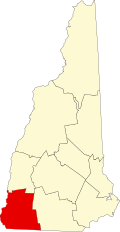Veterans' Memorial Hall | |
 | |
| Location | NH 32, Richmond, New Hampshire |
|---|---|
| Coordinates | 42°45′53″N72°16′9″W / 42.76472°N 72.26917°W |
| Area | 0.2 acres (0.081 ha) |
| Built | 1837 |
| Architect | Starkey, Oren |
| NRHP reference No. | 86002160 [1] |
| Added to NRHP | September 4, 1986 |
The Veterans' Memorial Hall, formerly the First Universalist Society Meeting House, is a historic community building on New Hampshire Route 32 in Richmond, New Hampshire. The 1+1⁄2-story clapboarded wood-frame building was built in 1837 by members of the local Universalist congregation. Richmond was the birthplace of Hosea Ballou, a theologian influential in the development of Universalism; he left the town before this building was built. As originally built, the meeting house had a small tower and belfry, which were removed in 1892 when the building was acquired by the local Grange. The building has seen only modest external alterations since then; the interior has had most of its religious trappings removed, but is also otherwise little altered. [2]
The building was listed on the National Register of Historic Places in 1986. [1] It is now owned by the town.


